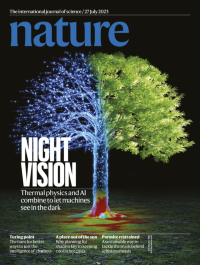Volume 619
-
No. 7971 27 July 2023
Night visionFrom robot helpers to autonomous cars, one key requirement for machines engaged in social interaction is the ability to perceive their surroundings. Well-lit conditions present few problems, but darkness currently poses considerable obstacles. In this week’s issue, Zubin Jacob and his colleagues present an AI-assisted approach that greatly improves night vision for machines. Called HADAR (heat-assisted detection and ranging), the system combines thermal physics and infrared imaging with machine learning to discern an object in pitch darkness as though it is illuminated by broad daylight. HADAR exploits thermal radiation laws to perceive texture and depth in darkness, giving greater accuracy than conventional thermal-imaging systems.
Spotlight
-
No. 7970 20 July 2023
Body imageLaunched in 2018, the Human Biomolecular Atlas Program (HuBMAP) aims to map how cell types are arranged in the human body. The initiative is both developing and then deploying the necessary technology to create maps of organs at single-cell resolution. In this week’s issue, three papers reveal early fruits of these labours. In the first paper, Michael Snyder and his colleagues use an imaging technique called CODEX and single-cell technologies to map the human intestine. In a second paper, Sanjay Jain and colleagues use spatial transcriptomics to map the human kidney. And in the third paper, Michael Angelo and co-workers use another imaging technique, called MIBI, to map the maternal–fetal interface. Together, these three maps at single-cell resolution hint at the power of spatial analyses in understanding human biology and disease.
-
No. 7969 13 July 2023
Troubled watersUsually, sea urchins procure blades of seagrass or small pieces of rubble to help them blend in with the sea floor, but the fire urchin (Asthenosoma varium) on the cover has instead appropriated the remnants of a blue plastic bag and is entangled in a discarded fishing line stuck on a reef. Taken at a depth of 130 metres in the Philippines, the image highlights the increasing grip of plastic pollution on the world’s ecosystems. In this week’s issue, two papers help to quantify the extent to which even remote water environments are being affected by plastics. Hudson Pinheiro and his colleagues focus on coral reefs, looking for plastic contamination in 84 reef systems in 25 locations across the Pacific, Atlantic and Indian Oceans. Veronica Nava and her co-workers examine microplastics in 38 lakes and reservoirs in 23 countries. Both teams come to the same conclusion: that plastic pollution is pervasive, and that monitoring and management should extend to all bodies of water.
-
No. 7968 6 July 2023
Shape shiftersDNA origami allows useful supramolecular structures to be created from templates. But the process has its limitations, with most structures confined to two configurations: folded or unfolded. In this week’s issue, Do-Nyun Kim and his colleagues present a method for reconfigurable folding of DNA that allows multiple dynamic shapes to be created. The researchers took the idea of repeatable folding and unfolding of a sheet of paper into different shapes as the inspiration for the construction of a DNA wireframe structured in the same way as pattern creases in origami. Using this, they were able to use nucleic-acid molecules, pH or light to trigger the folding, unfolding and refolding of the DNA into different shapes.




